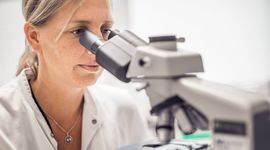Exon Skipping: Towards Personalised Treatment of JEB
New scientific publication from the Working Group Wally
Patients with junctional EB (JEB) induced by inherited mutations in the collagen 17 gene suffer from frequent blistering and wounding of their skin. This is due to reduced levels or complete absence of the collagen 17 (C17) protein, which usually keeps the skin layers connected. Although efforts developing causal therapies are underway, at present no cure is available for JEB patients. Thus, the development of topical treatments aiming to improve severly affected skin areas by repeated application represents an important alternative. In a recent study, researchers from the EB House examined the exon skipping method as a personalized treatment for JEB. The encouraging outcome was published in a renowned scientific journal.
Exons and introns are the building blocks of a gene. Since only the exons contain the genetic code for a protein, the introns are removed prior to protein production. The mature collagen 17 gene comprises 56 distinct exons stitched together, mutations in those can lead to faulty or missing protein. The exon skipping therapy uses a designed repair molecule (AON) that is delivered into the skin cells, where it specifically blocks the mutated exon, leading to its absence in the genetic code. As a consequence a shortened, however still functional protein is produced, that can assure the cohesion of the skin layers.
The JEB cells used for the laboratory experiments were harvested from the upper skin layer of a JEB patient with severe skin blistering. The cells show almost no C17 due to a mutation in the collagen 17 exon 7. Three different AONs were tested for exon 7 removal. The delivery of the AONs into the JEB skin cells led to the precise excision of the mutated exon, which resulted in a significant increase in C17.
To overcome the natural barrier of the outer skin layer for the topical AON application, the scientists packed the AON molecules into liposomes, which are fat molecules capable of penetrating intact skin. Application of color-stained AON-liposomes onto human skin pieces in the petri dish proved successful delivery into the nucleus of the cells in the upper skin layer. This is exactly where the gene repair should take place.
Finally, the scientists generated an artificial human skin with the AON-corrected JEB cells, which was retreated once with the AON liposomes. Analysis confirmed a correct deposition of C17 between the upper and lower skin layer, indicating full functionality of the AON-repaired C17 protein. The current study is an important step toward the development of AON exon skipping as a topical therapy for JEB patients.
To access the article please click here.
